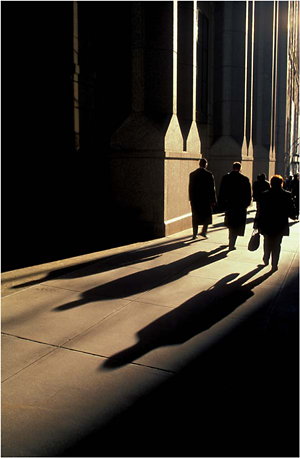
Wall Street, New York, USA
Early morning light beams down Wall Street highlighting the trudge to work in New York.
• Nikon F5, 17–35mm lens
Concrete
In the urban jungle there’s always something to point your lens at, whatever the time or weather. In the countryside, days, even weeks can go by waiting for the right conditions, but a few days spent working the melting pots of humanity will always be productive. Pounding the pavements of the world’s conurbations can be dispiriting, but who can fail to be stimulated by the vibrancy and variety of cities the world over? Bangkok: it’s not a pretty city. On my first visit I hated the choking fumes and oppressive sprawl. Now, after countless pit stops en route to exotic Asian destinations, I love it: the temples, tuk tuks, monks, street food, the bustle and life. Sydney: is there a better-sited capital anywhere in the world? Watching the sun shining down the harbour in the early morning, or catching the Opera House and Harbour Bridge as joggers trot past. Rome: all roads lead to it, which is easy to believe watching the traffic chaos around the Pantheon. A bowl of pasta in the Piazza Navona may set you back a few Euros, but when the lights come on in the Eternal City at dusk it’s a setting not to be missed.

Commuter on Millennium Bridge with St Paul’s on the skyline beyond, London, England
The steely light of a winter’s morning in London lights the elegant lines of the Millennium Bridge over the River Thames, leading the eye to St Paul’s Cathedral as a commuter hurries to work. It’s a classic example of the use of minimal colour.
• Canon EOS-1Ds MKII, 17–40mm lens

Gondolas at dawn, Piazza San Marco, Venice, Italy
Everyone should see Venice at least once in their lives. It doesn’t matter how many times you’ve seen pictures of it, the first impressions are as if you’ve stepped on to an opera stage. It has been a Mecca for artists for centuries and is endlessly inspiring. I’ve now been four times; maybe I should call it a day before the novelty of shooting bobbing gondolas wears off.
• Fuji GX617, 105mm lens
City parks are often exquisite mini-landscapes in the heart of a metropolis, and then there are the people in them, jogging, walking, snoozing; the ceremonies, the monuments, the markets, cafés, bars and restaurants – it’s endless. And of course, the street life. Photography aside, people-watching from a pavement café in the spring sunshine is an addictive pastime. Photographically, with so much on offer, the challenge is where to begin. All cities will have their classic views that have been shot ad infinitum, so coming up with something new, a unique take on a well-known subject, is the name of the game. Compositionally, you’re doing exactly what you do in other environments; arranging shapes, bearing in mind the Golden Rule of Thirds, looking for foreground interest and considering unsightly distractions. But as cities are all about people I like to include them, if possible. A few blurry figures in the key spot, even if tiny in the frame, can lift an image and give a sense of perspective and place. And bold compositions with graphic shapes from unusual viewpoints are the order of the day. Think laterally. Use your eyes. Bend your knees, or talk your way on to that rooftop terrace.
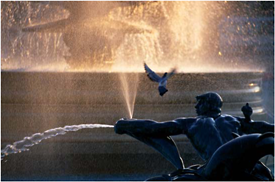
Fountain in Trafalgar Square with pigeons, London, England
The last of the sunlight backlights the fountain in Trafalgar Square. I managed to squeeze this one off before I was arrested and sent to a Gulag by the Tripod Police.
• Nikon F5, 80–200mm lens
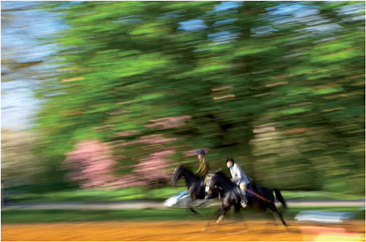
Horse riders in Hyde Park, London, England
It’s colour at full throttle for this study in motion of the Household Cavalry exercising their mounts in Hyde Park early in the morning. Spring is my favourite time for shooting cities; the parks are ablaze with colour.
• Canon EOS-1Ds MKII, 24–70mm lens
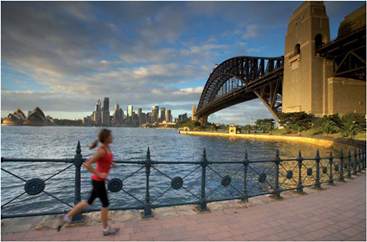
Jogger at Milsons Point, Sydney, New South Wales, Australia
Everywhere you go around Sydney Harbour they’re jogging, or rollerblading, or swimming; they’re a fit bunch the Aussies. I set this shot up with my cousin’s daughter trotting up and down endlessly while I experimented with different shutter speeds. As always, I think a human element lifts the wellknown view of the Harbour Bridge and skyline.
• Canon EOS-1Ds MKII, 17–40mm lens

Men playing pétanque, Barcelona, Spain
In the park in Barcelona the old boys gather for boules and a chat in the spring sun. Seems like a good way to pass the day to me.
• Nikon F5, 80–200mm lens

Salzburg in the snow, Austria
The previous evening in Salzburg I’d struggled up the hill above the Old Town with a sprained ankle and a cold to shoot the illuminated city. The floodlights never came on and I retreated to my hotel room feeling sorry for myself. The next morning the whole world looked a much better place as a light sprinkling of snow dusted the city.
• Fuji GX617, 105mm lens
The historical architecture of famous European cities just shouts to be photographed. The buildings speak to us of the passing of time and are often beautifully lit at night. Even the most unappealing area by day can be transformed when illuminated in the evening. Getting to know how a city is lit at night is part of the unique challenge of urban location searching. Making night images is all about planning and timing. Once an image has been pre-visualized and the exact composition planned, it’s a case of setting up as dusk falls and waiting for the lights to come on. The best night shots are not made in the dark; the ideal time is when the skies are darkening but still holding enough ambient light to give a rich, dark-blue tone to offset the warm tones of the lights. Shoot too early and the effects of the artificial lights aren’t apparent enough, leave it too late and the skies blacken. There’s usually a window of about five to ten minutes when the balance between night and day is perfect.
Cities are hard work, you’re on the go virtually all day and some of the night. Even in bad weather there are shots to be made, in fact I often wish for rain to turn pavements reflective at dusk. As well as the photography, there are the endless location searches, and struggling on and off the metro at rush hour with a monster camera bag and tripod in search of the next location is exhausting. Sometimes it’s necessary to carry the huge bag, but more often I know what sort of images I’m after and take the appropriate set up. If for example I’m working in a busy, crowded market I have just a body and two lenses and no tripod. Fill-flash can also be very useful here. I also love using a fast 85mm f/1.2 lens for portraits in crowded dark bazaars. But the one piece of kit I wouldn’t be without though for any city trip is my 24mm shift lens. Make a picture looking up at any building and what do you see? Converging verticals making it look as if the building is falling over backwards. It’s actually how we see it, but in print it just looks wrong. So architectural photographers have long used large-format cameras with movements enabling them to correct the verticals and keep everything straight by shifting the lens axis up or down to control the angle of view while keeping the image plane vertical. On 35mm or digital SLR cameras we can achieve the same by using a shift lens. They’re expensive, but mine has paid for itself many, many times over.
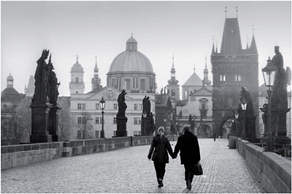
Charles Bridge at dawn, Prague, Czech Republic
The towers, statues and minarets of Prague’s Old Town take us straight back to the days of Mozart with no modern distractions to disrupt the skyline. On a grey overcast morning I’m struggling to make something of the Charles Bridge in the flat light. Just as I switch to black and white a couple strolls past hand in hand and I seize the moment.
• Nikon F5, 80–200mm lens

A lone figure on Via Cardinal Ferrari at night, Parma, Emilia-Romagna, Italy
I do like a bit of human blur in my night shots, just in the right place. As usual, it’s Wendy again as the ghostly figure in Parma.
• Canon EOS-1Ds MKII, 24mm shift lens
“Cities are hard work, you’re on the go virtually all day and some of the night”

Old car passing the Gran Teatro and Capitolio, Habana Vieja, Havana, Cuba
All the icons of Havana in one shot, the Capitol, Theatre and an old car. All I need is an old man with a cigar.
• Nikon F5, 17–35mm lens
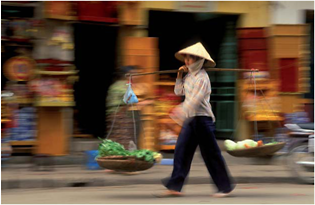
Street scene, Hanoi, Vietnam
For all the impressive monuments, it’s the human interest that defines a city. This street scene of a woman carrying vegetables typifies Hanoi.
• Nikon F5, 80–200mm lens
Cities do have their downsides. Somehow, a tripod when erected seems a magnet for every drunk, stag night gang and hustler in the city. Pickpockets and thieves are always in the back of my mind. And don’t get me on to the subject of the Tripod Police. They are a modern phenomenon, gangs of jobsworth so-called security guards hired specifically to stop photographers taking pictures from selected famous spots of their own national heritage without a permit costing a fortune applied for months in advance. Scaffolding is another bugbear. On one visit to Florence, green sheeting and scaffolding where restoration work was underway blighted every shot I tried. And while I’m at it, trying to sleep in hotel rooms not big enough to swing a cat in with the noise of late night revellers in the street outside and the amorous couple next door. And New York taxi drivers who don’t know the way to Broadway … But at the end of the day all environments have their specific challenges, and cities provide such rich pickings that they’re worth trudging the streets for.

Chillies, Chow Kit market, Kuala Lumpur, Malaysia
The stall holders in Kuala Lumpur’s Chow Kit market are somewhat bemused as I crouch within inches of their displays, holding the camera with one hand and a flash with the other. It’s a cramped, sweltering rabbit warren of stalls displaying all the colourful ingredients of Asian cuisine; fresh fish, chillies, vegetables, live chickens, lemongrass, spices … you name it. It’s also a hellhole of mixed lighting. Hard sunlight pierces gaps in the awnings, tungsten bulbs mix with fluorescent lights; hence the fill-in flash.
• Nikon F5, 17–35mm lens

Pad Thai noodles being stir fried on the Khao San Road, Bangkok, Thailand
The Khao San Road in Bangkok is a Mecca for all the backpackers and travellers passing through this corner of Asia. Pad Thai has to be the best street food in the world. I had the camera virtually in the wok to shoot this as the chilli sauce went in, and balanced the ambient light with the street lights and a dash of fill-in flash.
• Canon EOS-1Ds MKII, 24–70mm lens
Parisian Walkways
I’ve photographed Paris more than any other city. I find it an endlessly stimulating subject – every time I go I get fresh inspiration for the next time. Ideas are the key to avoiding just rehashing the famous views. There’s no getting away from the fact that the Eiffel Tower is a potent symbol of not just Paris but of all things French, but of course it has been done to death. There is simply no point in shooting the classic view from the Palais de Chaillot yet again. However, for icons as familiar as the Eiffel Tower it’s not necessary to show it all. One leg of the famous structure amongst the foliage beneath is enough. Long lenses, fish-eyes, unusual viewpoints, black and white and infrared film: they’re all useful tools in endeavouring to bring fresh perspectives to familiar subjects.

Tricolour blowing in wind at dusk, Arc de Triomphe, 17th arrondissement

River Seine and Eiffel Tower at dusk from Pont Alexandre III, 7th arrondissement



